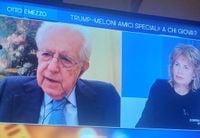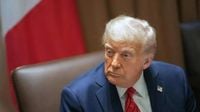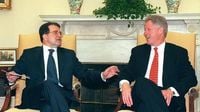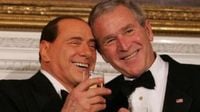The recent trip of Italian Prime Minister Giorgia Meloni to the White House for a meeting with U.S. President Donald Trump marks yet another significant chapter in the long history of diplomatic relations between Italy and the United States. This meeting, which took place amidst a backdrop of fluctuating international dynamics, adds Meloni's name to a roster of Italian leaders who have engaged with American presidents over the decades, each encounter reflecting the evolving political landscape.
Meloni's visit is not just a routine diplomatic engagement; it signifies a personal rapport and ideological alignment with Trump, who has praised her as a leading figure among European leaders. This relationship is particularly noteworthy given the historical context of Italy's political interactions with the U.S., dating back to the post-World War II era.
In 1947, Italian Prime Minister Alcide De Gasperi met with President Harry Truman, a pivotal moment that helped secure crucial economic aid for a war-torn Italy. This meeting not only enhanced Italy's credibility on the international stage but also positioned the country as a key player in the Western democratic alliance. De Gasperi's efforts were instrumental in integrating Italy into the global economic framework, setting a precedent for future leaders.
Fast forward to July 1963, when Antonio Segni welcomed President John Fitzgerald Kennedy to Rome. This visit was marked by Kennedy's support for the Moro-socialist alliance in Italy, highlighting the U.S. commitment to fostering democratic governance in Europe. Tragically, just four months after this diplomatic engagement, Kennedy was assassinated, underscoring the fragility of political stability.
Another significant meeting occurred in July 1977, when Giulio Andreotti met with President Jimmy Carter. Their discussions focused on the tense relations with the Soviet Union and strategic maneuvers in the Middle East, reflecting the geopolitical concerns of the Cold War era. This meeting was emblematic of the ongoing collaboration between the two nations during a time of global uncertainty.
On October 20, 1983, Bettino Craxi met with President Ronald Reagan, a relationship that would later be tested by the Sigonella crisis, which strained U.S.-Italian relations. However, their initial encounter was marked by mutual respect and a shared commitment to addressing international issues.
In more recent history, the meeting between Romano Prodi and Bill Clinton in May 1998 focused on economic development and international stability, illustrating the continued importance of economic ties between the two nations. Similarly, the October 13, 2008, meeting between Silvio Berlusconi and George W. Bush at Camp David was notable for the honors bestowed upon Berlusconi, showcasing the strong personal rapport between the two leaders.
The dynamics shifted during Barack Obama's presidency, particularly with his meeting with Berlusconi on June 16, 2009, which was marked by a noticeable chill in relations compared to previous encounters. This meeting, however, remained the only bilateral discussion between the two leaders during their respective terms, highlighting a significant cooling in U.S.-Italian relations.
Mario Monti's tenure as Prime Minister saw him present a plan to address Italy's economic crisis to Obama, positioning him as the first European leader to engage with the U.S. following the Euro-saving Pact. Monti's approach was characterized by a desire to restore Italy's standing on the international stage.
In April 2015, Matteo Renzi met with Obama to discuss pressing issues such as international terrorism, immigration, and the situation in Libya, further demonstrating the breadth of topics covered in these high-level meetings.
More recently, in August 2019, Giuseppe Conte engaged with Trump during the G7 summit in France, where Trump affectionately referred to him as "Giuseppi." This meeting underscored a personal connection, with Conte describing Trump as "a man of talent," illustrating the informal rapport that can sometimes develop between leaders.
Meloni's recent meeting with Trump is significant not only for its immediate political implications but also for its potential to shape the future of Italy's role within Europe. As Meloni navigates her position as a leader of a nation with a complex political landscape, she faces the challenge of balancing her relationship with Trump while promoting European interests. Trump's endorsement of Meloni as a favored leader among Europeans presents both opportunities and risks, as she must tread carefully to maintain her credibility on the European stage.
Political analysts have noted that while Meloni may enjoy a personal connection with Trump, she must also contend with the broader implications of aligning too closely with his administration, particularly given Trump's controversial actions, such as the January 6, 2021, Capitol Hill insurrection.
In discussions following Meloni's visit, prominent figures like former Prime Minister Mario Monti have lauded her diplomatic efforts as a political success. Monti highlighted that Meloni effectively avoided the contentious issue of tariffs, thereby sidestepping a potential political landmine. This approach has been seen as a strategic move to bolster her position both domestically and within the European Union.
Monti's assessment reflects a broader sentiment among political commentators who view Meloni's meeting with Trump as a calculated success, one that allows her to navigate the complexities of international relations without compromising her standing at home.
As Meloni continues to engage with global leaders, the historical context of Italy's diplomatic relations with the U.S. serves as a reminder of the delicate balance between national interests and international alliances. The legacy of past meetings between Italian and American leaders underscores the importance of these engagements in shaping the future of transatlantic relations.
In conclusion, Meloni's visit to the White House is a continuation of a long-standing tradition of diplomatic interactions between Italy and the United States. As she forges her path in international politics, the lessons of history will undoubtedly influence her approach to navigating the complexities of global diplomacy.







